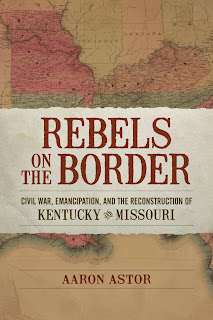I am on quite the roll with my selection of reading material of late. Everything I seem to pick up and read I find well written and very informative. My latest read certainly didn't disturb the trend.
Rebels on the Border: Civil War, Emancipation, and the Reconstruction of Kentucky & Missouri, by Maryville (TN) College professor Aaron Astor is all that I had been anticipating since finding out about its then forthcoming release this past spring.
In Rebels on the Border, Astor covers so much ground so well, it is difficult choose a place to begin. So, let's start chronologically. Astor provides excellent context to help the reader understand why the slaveholding border states of Kentucky and Missouri chose the direction they did in the Civil War. A lot of the similarity between the two states in politics, economy, agriculture and society has to do with lateral migration. Simply put, many Kentuckians migrated to Missouri. As they did, they naturally brought their understanding of things with them.
Slavery was one important thing that both states shared, but it was not simply slavery, but a similar system of slavery. Both states' slaveholders for the most part held small numbers of slaves and produced similar crops such as grains, tobacco and hemp. And, although at the outbreak of the war Kentucky had a much larger population of slaves than her sister state to the west, the main areas that Astor concentrates on - the Bluegrass region of Kentucky and "Little Dixie" of central Missouri - were close in demographics.
Astor contends that Kentucky and Missouri rejected secession in large part due to tradition and order. He writes, "If one ideal characterized late antebellum border state life more than any other, it was the desire for order - social, economic, racial, and ultimately political order. The thirst for order in a region challenged by both abolitionism and secessionism stood as the central pillar to antebellum upper South social thought. It would trump all concerns about sectional honor in the ensuing crisis, revealing a population that embraced slavery and Union..." These two border states to a large degree viewed the Confederacy as shaky ground, a fledgling government without the stability that the Union had delivered over decades of agitation on the slavery question. Astor quotes a Bourbon County Kentuckian who explained that his fellow Bluegrass brethren would never submit to secession. "They [Kentuckians] love order, peace and freedom, and these priceless blessings can be secured only by sustaining the Union, the Constitution and the laws."
Astor's study focuses on the evolution of African Americans in these border states too. He argues that due to the upheaval of war blacks sought out ways to turn their methods of resistance during slavery into ways to have a political say after freedom came. He writes, "Before most black Kentucky or Missouri soldiers fired their guns for the Union army, the system of slavery had collapsed in many parts of the slave-rich Little Dixie and Bluegrass regions. Guerrilla rebels against Unionism colluded, ironically, with black rebels against conservatism to usher out the social and political order that had prevailed for decades in the border states. Only through complete social revolution and a veritable race war between 1864 and 1866 would the border states confront and create a new social and political order."
Understanding these issues then, it is not difficult to see how many people in these border states migrated from a Unionist sympathy to a more Confederate outlook in the last years of war and into Reconstruction and beyond. Upheavals such as the Emancipation Proclamation, enlistment of black soldiers and the usurpation of state laws by the federal government went a long way toward destabilizing these border states citizens' worlds.
The stories that Astor uncovered to tell the Reconstruction story in these two regions are fascinating and tragic. The violent degree to which Kentuckians and Missourians sought to maintain social, economic and political control despite legislative enactments such as the 13th, 14th and 15th amendments are disturbing to us today, but to whites in those areas at that time they were seen as viable and justifiable attempts to maintain that ordered society that had been so important to them for generations.
I highly recommend Rebels on the Border to those who wish to understand the crucial and unique place that the border states of Kentucky and Missouri played in the Civil War era. On a scale of 1 to 5, I give it a full 5!
Wednesday, July 4, 2012
Subscribe to:
Post Comments (Atom)








No comments:
Post a Comment